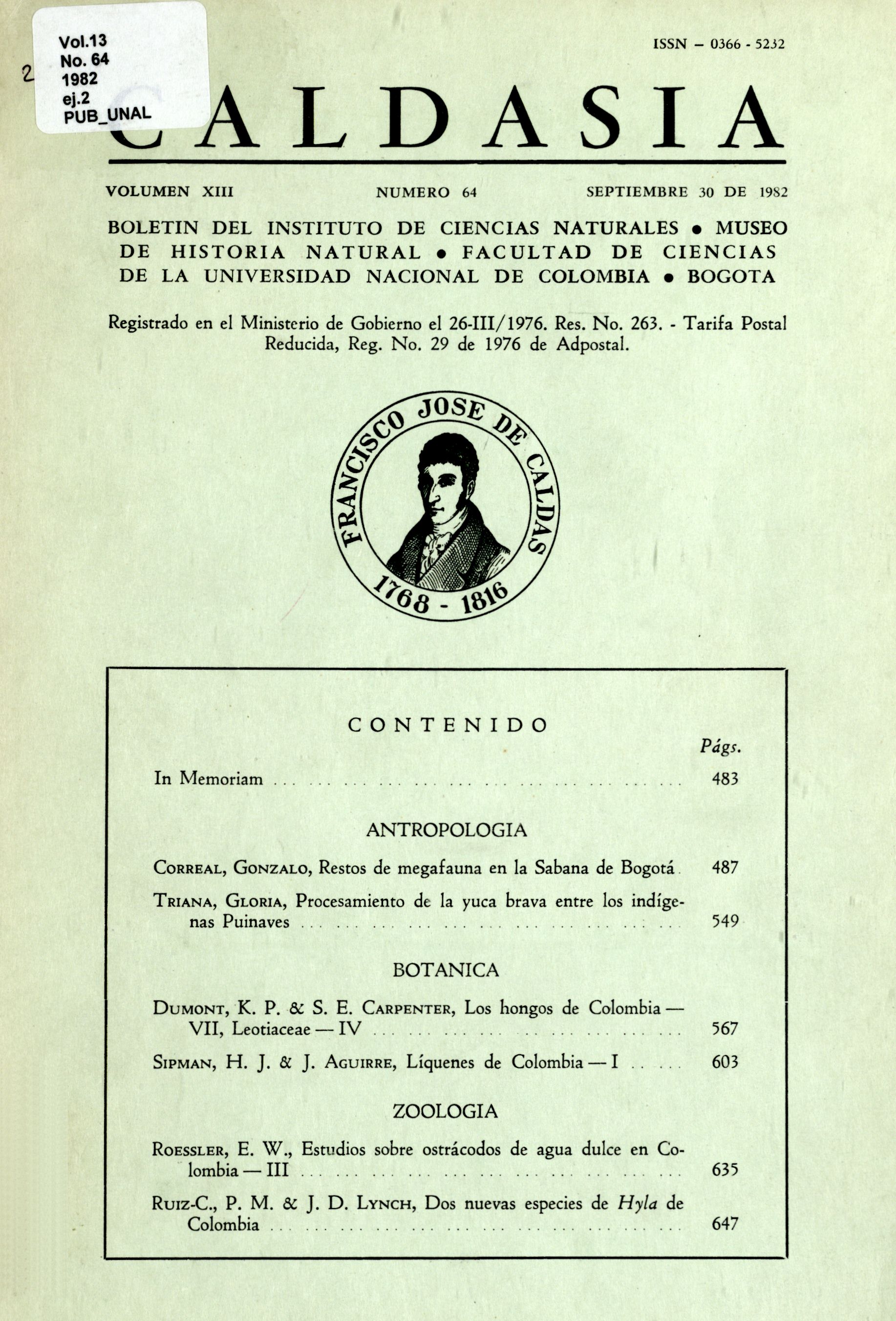Los hongos de Colombia - VII: Leotiaceae - IV: Hymenoscyphus Caudatus and related species from Colombia and adjacent regions
Palabras clave:
Leotiaceae, Hymenoscyphus Caudatus, Ascomycetes (es)Leotiaceae, Hymenoscyphus Caudatus, Ascomycetes (en)
Descargas
The present paper redescribes and illustrates five common species of Hymenoscyphus, H. caudatus, H. serotinus, H. affin. scutulus, H. Iasiopodtum & H. sclerogenus, from Colombia and adjacent regions in South America. Emphasis is given to discussions of anatomical and morphological variability and host specificity of the species included. Inoperculate Discomycetes are generally small Ascomycetes producing an apothecium as their sexual fruiting structure. The largest order, the Helotiales, contains 5 families: Dermateaceae, Hyaloscyphaceae, Orbiliaceae, Sclerotiniaceae and Leotiaceae, In recent years there have been several monographic and submonographic studies on selected genera within these families, but no definitive studies on the principal family, Leotiaceae (previously referred to as the Helotiaceae), has been prepared. These studies have resulted in a better understanding of some of the family limits, but most of the generic limits still remain vague and confused. This is especially true for Hymenoscyphus (previously referred to by most workers as Helotium), which for decades has been the depository for small Discomycetes of uncertain affinities. White (1942, 1942-a, 1943, 1944) began to work systematically through the species of Hymenoscyphus and to bring order out of the existing chaos. His carefully prepared descriptions, meticulously drawn illustrations, and long synonymies were the real important contribution to the understanding of the genus. The most recent attempts to study Hymenoscyphus have been by Dennis, who summarized his works in 1964 (Dennis, 1964). However, as Dennis himself points out, he was unable to come to a sound understanding and arrangement of the species because of the extent of the problems, and the resulting treatment is rather artificial. He relied heavily upon substrate and geographical relations, rather than true morphological similarities. We agree with Dennis, that this has resulted in the separation of closely related taxa and an "unnecessary proliferation of names". Although Dennis contributions were extraordinary in terms of the number of described species he examined and in his literature searches, he did not have at his disposal necessary tropical collections for a complete comprehension of the individual species and/or the entire genus. Further, as pointed out by Dumont (1976), because of limited collections Dennis was unable to understand the full morphological and geographical variation of certain species and recognized several taxa, when in the final analysis only one existed. Many of these deficiencies are apparent in his monumental work on "The Fungus Flora of Venezuela and Adjacent Countries" (Dennis, 1970). In Hymenoscyphus for example, he included only seven species (in his 1964 treatment he included more than 70 species for the world), and of these three, H. crocatus , H. caracassensis and H. atrosubiculatum have been removed from the genus by Dumont (1974) and Dumont and Pal (1978). Arendholz (1979) has recently provided a very important contribution to the understanding of several species of leaf inhabiting species of Hymenoscyphus. Again, as with previous workers, his work stressed temperate collections and temperate species. The purpose of the present study is to report the findings of some of our tropical collecting, to expand the understanding of five species of Hymenoscyphus which appear to be common in northern South America, to discuss the morphological variability observed, and to comment on the host or substrate specificity (or lack of it) within certain taxa. The materials and methods used during these studies are the same as those reported by Dumont (1972). The following is a key to the five species reported herein.
Cómo citar
APA
ACM
ACS
ABNT
Chicago
Harvard
IEEE
MLA
Turabian
Vancouver
Descargar cita
Visitas a la página del resumen del artículo
Descargas
Licencia
Derechos de autor 1982 Caldasia

Esta obra está bajo una licencia internacional Creative Commons Atribución 4.0.
Aquellos autores/as que tengan publicaciones con esta revista, aceptan los términos siguientes:
- Los autores/as conservarán sus derechos de autor y garantizarán a la revista el derecho de primera publicación de su obra, el cual estará simultáneamente sujeto a la Licencia de reconocimiento de Creative Commons que permite a terceros compartir la obra siempre que se indique su autor y su primera publicación esta revista.
- Los autores/as podrán adoptar otros acuerdos de licencia no exclusiva de distribución de la versión de la obra publicada (p. ej.: depositarla en un archivo telemático institucional o publicarla en un volumen monográfico) siempre que se indique la publicación inicial en esta revista.
- Se permite y recomienda a los autores/as difundir su obra a través de Internet (p. ej.: en archivos telemáticos institucionales o en su página web) antes y durante el proceso de envío, lo cual puede producir intercambios interesantes y aumentar las citas de la obra publicada. (Véase El efecto del acceso abierto).
























